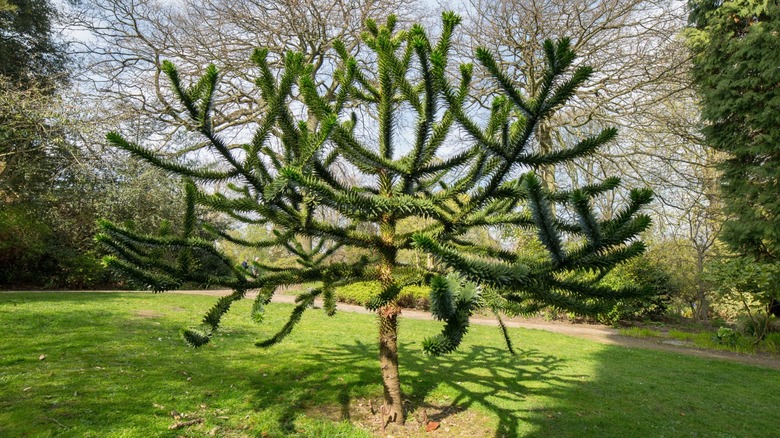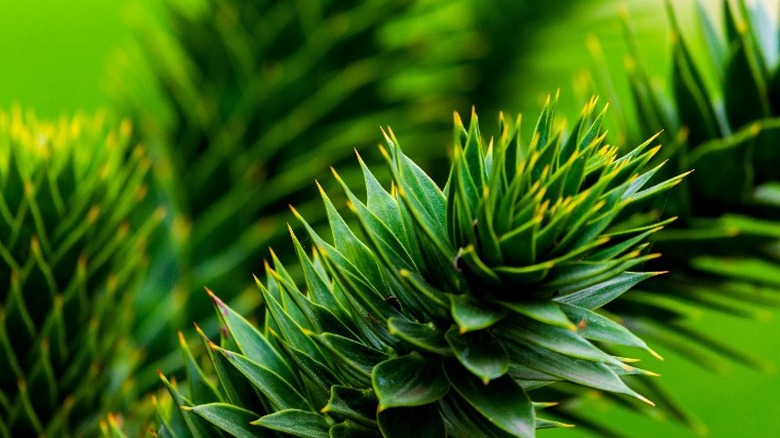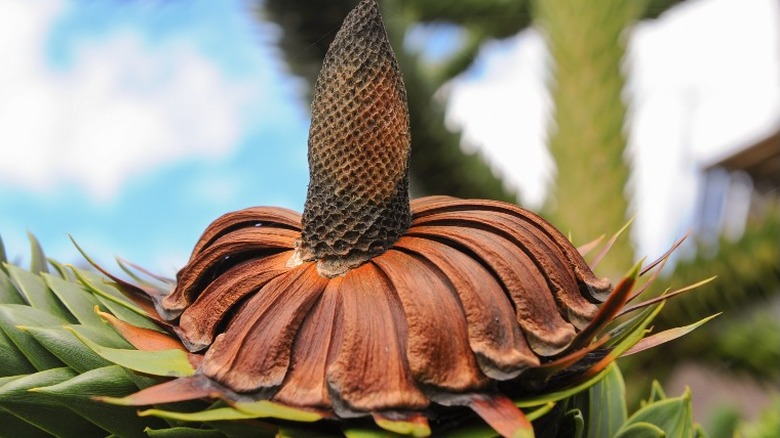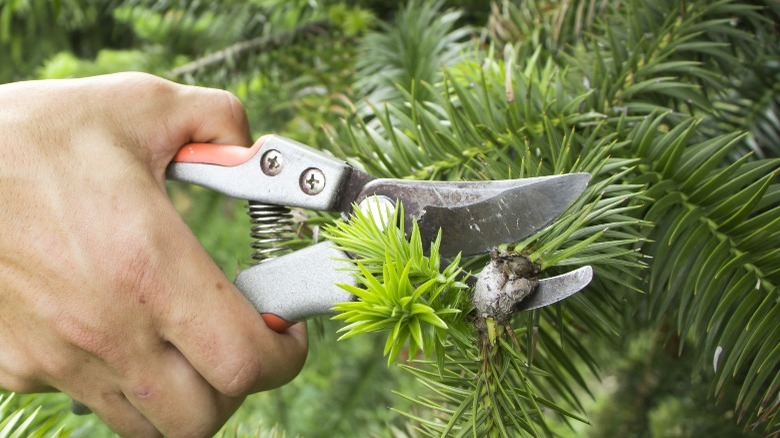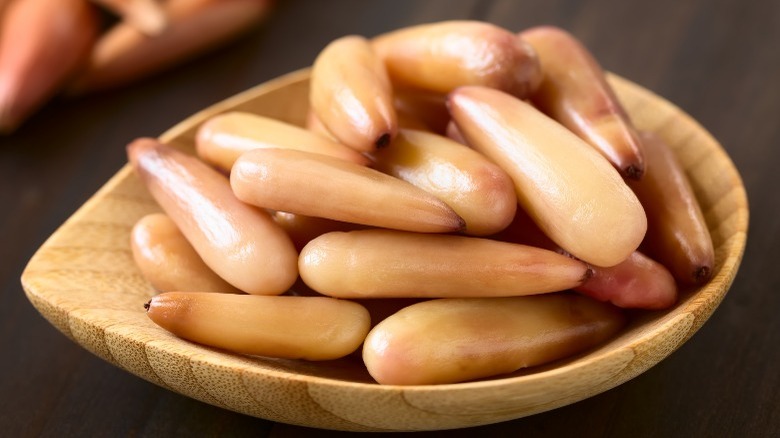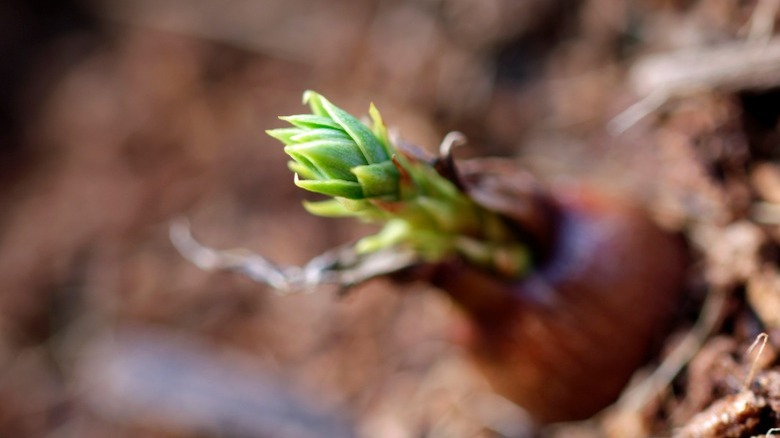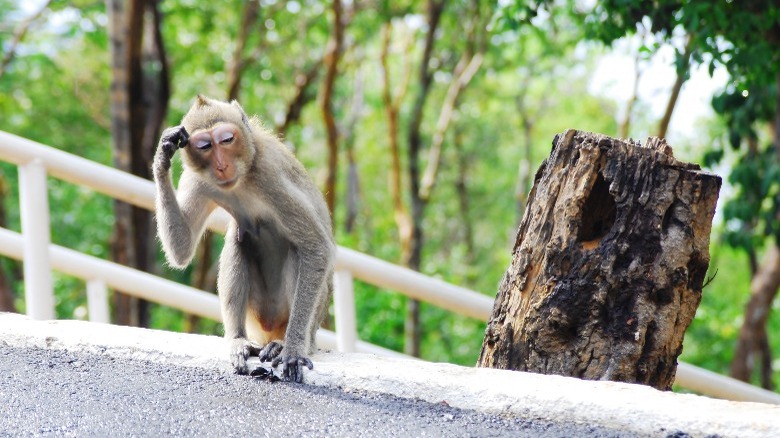How To Care For A Monkey Puzzle Tree
Araucaria araucana, more commonly known as the monkey puzzle tree, is one of the most striking ornamental trees out there. A true living fossil, the species have been around since the times of the dinosaurs, and as The Guardian points out, some of the oldest specimens still alive today were saplings in Medieval times.
The monkey puzzle has dark green, sharp leaves, and cones full of seeds. The leaves form an armor-like spiral pattern that coats the tree's upper limbs like scales. As The Spruce explains, these deter animal predators from snacking on the tree and provide the species a degree of fire resistance, which helps to explain why these bizarre, beautiful trees have survived so many thousands of years.
The native habitat of the monkey puzzle tree is remarkably small these days though. Two distinct locations, which are in total less than a quarter of the size of London, are found on either side of the Andes mountains in Chile. In fact, the tree is also known as the Chilean pine. Unfortunately, these areas have been ravaged by deforestation and forest fires. According to Gardener's World, it can take decades for monkey puzzle trees to produce seeds, which is why many gardeners outside of Chile are making an effort to preserve the species. Luckily for them, it is a beautiful and easy-to-grow tree that will thrive in all but the most extreme environments, provided you have enough space for it.
How to use a monkey puzzle tree in garden
Monkey puzzle trees will eventually grow to a considerable size, per Seasonal Gardening. Mature specimens can reach over 60 feet tall and 30 feet across, thus making them less than ideal for small gardens. The spines and cones are incredibly spiky and prickly, so it's advised not to plant them where they may intrude onto walkways or other high-traffic areas. If you don't have sufficient space, then perhaps choosing a smaller tree would be better.
Gardening Know How notes that while monkey puzzle trees have a preference for well-draining soil and full sunlight, they are survivors who will adapt to almost any soil condition, and can tolerate partial shade. Once established, monkey puzzle trees require very little maintenance. The most important factors for their success are choosing an appropriate location, and providing a thorough watering once or twice a week for the first year after planting.
Monkey puzzle trees help to create a wow factor in a garden. The details of the plant are both beautiful and fascinating, with intricate swirls of leaves and myriad tapering offshoots. But for the full, most spectacular effect, it needs to be viewed from a distance. Savvy landscapers usually place a monkey puzzle tree in a visible but distant part of the garden in order to best appreciate it — and avoid getting pricked by the sharp leaves.
How to grow a Monkey Puzzle tree
The primary consideration for anyone considering growing monkey puzzle trees is location. Fast Growing Trees confirms that choosing a spot with the ideal sunlight conditions is practically all that's required. Monkey puzzle trees prefer either full sunlight in mild zones or partial shade in hotter areas where a few hours of respite from direct sunlight will help to prevent the tree from drying out.
In order to grow a monkey puzzle tree from seed, Gardener's World points out that it's crucial to use the freshest seeds possible and soak them in water for 24 hours before sowing. Sow them pointed end down, with the tops uncovered by soil, and germinate in a sunny, warm place. This may take a few months. Once they are large enough, repot and grow for two to three years before planting out in the garden.
Once your seedlings have fully propagated, gently remove the plant from its pot and stand the sapling in water while you prepare the site. Dig a hole that's wider than the pot and roughly the same depth. You can add some fertilizer, sand, or amendment to the soil if desired, but unless you have particularly poor soil it's not required. Stand the tree in the hole with the top of the root ball level with the ground. Backfill the hole with soil and ensure the tree is standing straight. Water it well and keep watering every one to two weeks for the first year.
How to care for a monkey puzzle tree
Monkey puzzle trees are extremely easy to grow, states Trees.com. In fact, it has taken millions of years, continued deforestation, and unprecedented wildfires to even begin to endanger them. Typically monkey puzzle trees thrive best in USDA climate zones 7b to 11, which means that although they can tolerate minimum temperatures as low as 5 degrees Fahrenheit, they will need adequate protection from frost (via Gardenerdy).
Watering in the first year should be regular and weekly, or at minimum once every two weeks, in order to ensure the young tree establishes itself. After the first year, watering can be reduced to once every two weeks, or whenever the top three inches of soil around the tree are dry, which should be enough to keep these hardy survivors thriving.
In terms of other maintenance, such as fertilizing and pruning, the monkey puzzle tree will only require intervention in exceptional circumstances. If you are growing your tree in a particularly hot climate with poor soil, some all-purpose fertilizer will help with the extra pace of growth and reduced nutrient levels. Pruning should only happen in early spring and is only necessary to remove dead or broken branches. If you want to make aesthetic changes such as removing lower branches, this should also happen in the spring, but isn't required for the tree's continued health and growth.
Are monkey puzzle trees toxic?
As Van den Berk Nurseries explains, the monkey puzzle tree's defenses are physical rather than chemical, and they are non-toxic to humans, livestock, and large pets. Their unique foliage and tough exterior provide them enough protection without needing toxins to discourage grazing animals.
In fact, the seeds of the monkey puzzle tree are a staple of the diet of the indigenous people in its native range. According to the Eden Project, the local name for the tree is the Pehuén, and it is sacred to the Pehuenche people of Coastal Cordillera Chile.
Treehugger further explains that at a feast thrown by the Governor of Chile in 1795, Pehuén seeds were served to the guests, including the surgeon and naturalist Archibald Menzies. He then carried some of those seeds with him on Captain George Vancouver's round-the-world voyage. As a result, five healthy plants made it back to Great Britain, and the monkey puzzle tree was introduced to Europe.
How to repot a monkey puzzle tree
Your monkey puzzle tree will require repotting every few years or so. It's important to note that repotting can be stressful for any plant, especially for evergreens like the monkey puzzle. As Garden Ninja suggests, most trees need to be planted out in the ground for best results and monkey puzzle trees are no exception. But for the first few years of its growth, pots can be useful for taking care of young trees in marginal environments.
Planta describes a standard process for transplanting conifers. When you're ready to repot your monkey puzzle tree, make sure you have an appropriately sized container to move it to. Water the tree very well, as this will help to loosen the soil. Gently remove the plant from the pot, loosening around the edges with a knife if needed. Take this chance to prune the roots of any unhealthy, moldy, rotting, or over-tangled bits.
Remember you want the top of the root ball to be level with the top of the soil, which should be an inch or so below the edge of the pot. Fill the new pot with a layer of soil that's of an appropriate depth, put the plant down on top of the soil, and backfill around the roots until it's stable and well-supported. Water the plant well and add extra soil if the watering reveals gaps where it's needed.
Why is it called a monkey puzzle tree?
These ancient evergreens are of immense social and cultural importance in their native South America. They are recognized as the national tree of Chile and appear on many flags and emblems of national parks, both there and in neighboring Argentina. However, as previously mentioned, the indigenous people of Chile never referred to them as monkey puzzle trees, but instead, use the name Pehuén. According to Cultural Survival, the trees are a focal point of their religious, culinary, and spiritual lives. Their relationship with the trees even inspired a name for themselves: Pehuenche, or "people of the trees."
After the seeds of the Pehuén tree began their voyage from South America to Europe, the surviving saplings took root in English soil. Although there are competing claims as to who exactly inspired the new name, the Woodland Trust maintains that a witty visiting barrister named Charles Austin commented, "that tree would be a puzzle for even a monkey to climb," and the just name stuck!
